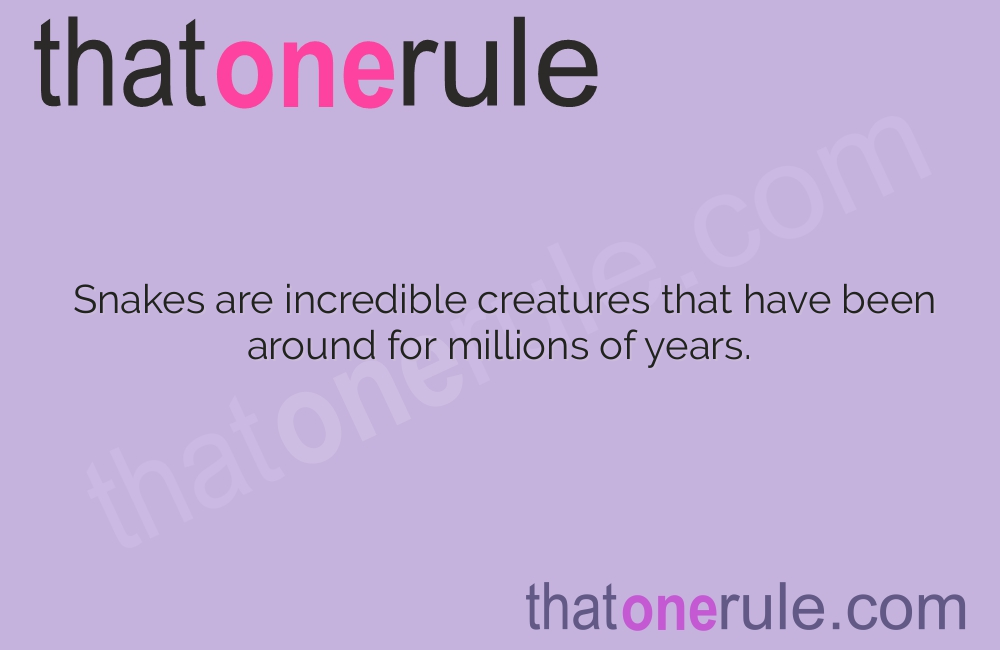Fascinating Facts about Snakes

Snakes are incredible creatures that have been around for millions of years.
There are approximately 3,600 species of snakes worldwide.
Snakes are found on every continent except Antarctica.
The longest snake in the world, the reticulated python, can grow up to 30 feet in length.
Not all snakes are venomous. In fact, only about 600 species are venomous.
Snakes do not have eyelids, so they cannot blink.
Snakes smell with their tongues, which collect particles from the air and transfer them to their Jacobson’s organ.
Some snakes can go months without eating, while others may eat several times a week.
The fastest snake in the world, the black mamba, can travel at speeds of up to 12 mph.
Snakes are ectothermic, meaning they rely on external heat sources to regulate their body temperature.
Snakes shed their skin several times a year, to allow for growth.
The inland taipan has the most potent venom of any snake, capable of killing a human within minutes.
Snakes can dislocate their jaws to swallow prey much larger than their own heads.
Some snake species, like the king cobra, can stand up and spread their necks when threatened, creating a menacing display.
Snakes are generally not aggressive towards humans, and most bites occur when they feel threatened or provoked.
The green tree python uses its vivid green coloration to blend in with foliage and ambush its prey.
Fascinating Facts about Snakes part 2
Some snake species, like the spectacle cobra, have hoods that can expand to appear larger or intimidate foes.
The slowest snake in the world, the rough-scaled python, can move at a speed of only 0.1 mph.
Snakes have a unique mode of locomotion called concertina movement, where they grip their surroundings and pull themselves along.
The black mamba’s venom is extremely potent, but it is not always fatal to humans if prompt medical treatment is received.
The burmese python is one of the largest snake species, capable of reaching lengths of over 20 feet.
Some sea snake species can stay underwater for up to two hours before resurfacing to breathe air.
The king cobra’s venom is powerful enough to kill an elephant.
Snakes have a specialized jaw structure, with flexible ligaments, that allows them to swallow prey whole.
Snakes use their forked tongues to smell the environment, helping them locate prey and navigate their surroundings.
The boomslang snake has a highly potent venom that can cause internal bleeding and has no known antidote.
Snakes are an essential part of ecosystems, controlling populations of rodents and other small animals.
The gaboon viper has the longest fangs of any venomous snake, reaching up to two inches in length.
Many snake species, like the rainbow boa, are renowned for their vibrant and iridescent scales.
A snake’s diet primarily consists of rodents, birds, other reptiles, and sometimes even small mammals.
Some snake species, like the eastern coral snake, have brightly colored patterns to signal their venomous nature.
In some cultures, snakes are revered as symbols of wisdom, fertility, or even rebirth.
The ball python is one of the most popular pet snake species due to its docile nature and beautiful patterns.
Certain snake species, like the copperhead, have heat-sensitive pits on their faces, allowing them to detect warm-blooded prey in the dark.
Some snakes, like the hognose snake, are known for their elaborate bluffing behavior, playing dead to deter predators.
The sidewinder snake has a fascinating sideways movement, allowing it to traverse sandy terrain with ease.
The scales on a snake’s belly, known as ventral scales, are used for gripping surfaces and aid in movement.
The cobra’s iconic hood serves as a warning display, making the snake appear larger and more intimidating.
Snakes have flexible jaws that allow them to swallow prey much larger than their head, aided by ligaments and elastic skin.
The rattlesnake’s rattle is composed of segments of keratin, the same material as human fingernails.
Some snakes, like the black mamba, release a potent neurotoxin that can cause paralysis and death within hours if left untreated.
Snakes have been a subject of fascination and fear in many cultures since ancient times, often portrayed in mythology and literature.
The king cobra can accurately spit its venom at a target up to 8 feet away, causing temporary blindness and extreme pain.
Snakes have a unique reproductive system, with most species laying eggs, but some giving live births, like the boa constrictor.
Despite their reputation, snakes play a crucial role in maintaining the balance of ecosystems and should be respected and protected.
